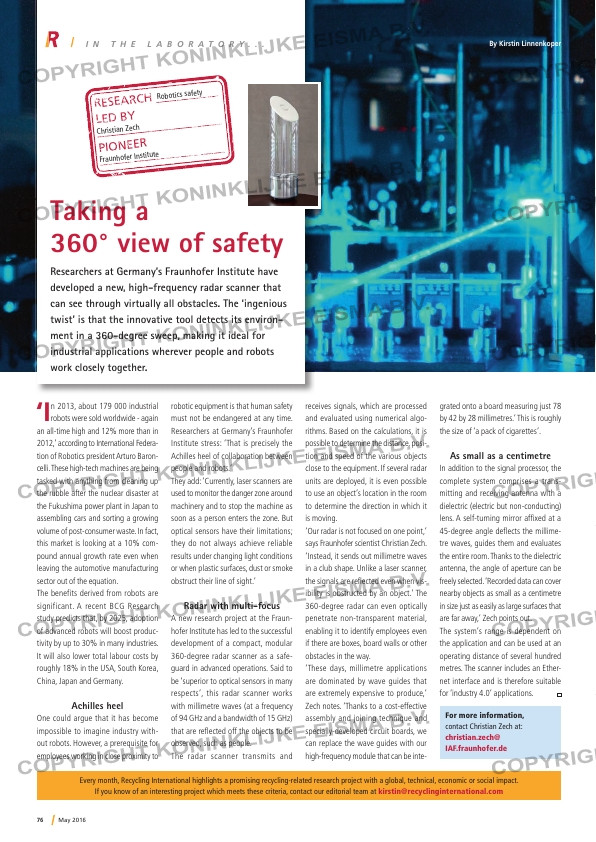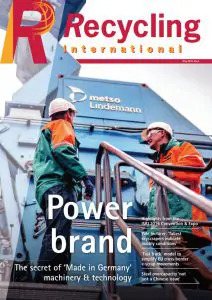Page 76 from: May 2016

76 May 2016
I N T H E L A B O R A T O R Y . . .
‘In 2013, about 179 000 industrial robots were sold worldwide – again
an all-time high and 12% more than in
2012,’ according to International Federa-
tion of Robotics president Arturo Baron-
celli. These high-tech machines are being
tasked with anything from cleaning up
the rubble after the nuclear disaster at
the Fukushima power plant in Japan to
assembling cars and sorting a growing
volume of post-consumer waste. In fact,
this market is looking at a 10% com-
pound annual growth rate even when
leaving the automotive manufacturing
sector out of the equation.
The benefits derived from robots are
significant. A recent BCG Research
study predicts that, by 2025, adoption
of advanced robots will boost produc-
tivity by up to 30% in many industries.
It will also lower total labour costs by
roughly 18% in the USA, South Korea,
China, Japan and Germany.
Achilles heel
One could argue that it has become
impossible to imagine industry with-
out robots. However, a prerequisite for
employees working in close proximity to
robotic equipment is that human safety
must not be endangered at any time.
Researchers at Germany’s Fraunhofer
Institute stress: ‘That is precisely the
Achilles heel of collaboration between
people and robots.’
They add: ‘Currently, laser scanners are
used to monitor the danger zone around
machinery and to stop the machine as
soon as a person enters the zone. But
optical sensors have their limitations;
they do not always achieve reliable
results under changing light conditions
or when plastic surfaces, dust or smoke
obstruct their line of sight.’
Radar with multi-focus
A new research project at the Fraun-
hofer Institute has led to the successful
development of a compact, modular
360-degree radar scanner as a safe-
guard in advanced operations. Said to
be ‘superior to optical sensors in many
respects’, this radar scanner works
with millimetre waves (at a frequency
of 94 GHz and a bandwidth of 15 GHz)
that are reflected off the objects to be
observed, such as people.
The radar scanner transmits and
receives signals, which are processed
and evaluated using numerical algo-
rithms. Based on the calculations, it is
possible to determine the distance, posi-
tion and speed of the various objects
close to the equipment. If several radar
units are deployed, it is even possible
to use an object’s location in the room
to determine the direction in which it
is moving.
‘Our radar is not focused on one point,’
says Fraunhofer scientist Christian Zech.
‘Instead, it sends out millimetre waves
in a club shape. Unlike a laser scanner,
the signals are reflected even when vis-
ibility is obstructed by an object.’ The
360-degree radar can even optically
penetrate non-transparent material,
enabling it to identify employees even
if there are boxes, board walls or other
obstacles in the way.
‘These days, millimetre applications
are dominated by wave guides that
are extremely expensive to produce,’
Zech notes. ‘Thanks to a cost-effective
assembly and joining technique and
specially-developed circuit boards, we
can replace the wave guides with our
high-frequency module that can be inte-
grated onto a board measuring just 78
by 42 by 28 millimetres.’ This is roughly
the size of ‘a pack of cigarettes’.
As small as a centimetre
In addition to the signal processor, the
complete system comprises a trans-
mitting and receiving antenna with a
dielectric (electric but non-conducting)
lens. A self-turning mirror affixed at a
45-degree angle deflects the millime-
tre waves, guides them and evaluates
the entire room. Thanks to the dielectric
antenna, the angle of aperture can be
freely selected. ‘Recorded data can cover
nearby objects as small as a centimetre
in size just as easily as large surfaces that
are far away,’ Zech points out.
The system’s range is dependent on
the application and can be used at an
operating distance of several hundred
metres. The scanner includes an Ether-
net interface and is therefore suitable
for ‘industry 4.0’ applications.
Taking a
360° view of safety
Researchers at Germany’s Fraunhofer Institute have
developed a new, high-frequency radar scanner that
can see through virtually all obstacles. The ‘ingenious
twist’ is that the innovative tool detects its environ-
ment in a 360-degree sweep, making it ideal for
industrial applications wherever people and robots
work closely together.
By Kirstin Linnenkoper
Every month, Recycling International highlights a promising recycling-related research project with a global, technical, economic or social impact.
If you know of an interesting project which meets these criteria, contact our editorial team at [email protected]
For more information,
contact Christian Zech at:
christian.zech@
IAF.fraunhofer.de
RESEARCH
LED BY
PIONEER
Roboti
cs safety
Christian Zech
Fraunhofer Ins
titute
iRECY – the Mobile Office
iRECY app provides not only the usual functionality of a CRM
system like communication and planning of activities, but also a
complete information system on purchase and sales transactions,
shipped material, contracts, scale tickets, prices, open receivab-
les, runs, and container transactions as well as documents and
photos from our electronic archive. Your buyers will love it!
RECY Business Management Software
for the Recycling and Waste Management Industry
You find further information in the Internet: www.recy-systems.com
More …
Mobile Grading
Use this exciting app on a smartphone for the receiving of
material on your yard. Faster, smarter, and more secure than any
process that you currently use. Photos of the received material
improve quality of data and control for the buyers, and can also
serve as proof in case of claims. There was never a better way of
making sure that you got what you pay for!
Fleet Control / Container Tracking
Your drivers communicate with your dispatch through a tablet in
the truck. Your dispatch knows at all times where their trucks are
and which customer is served right now and next. The drivers
track barcoded containers with an app on their smartphone.
They can use the same app for taking photos and collecting
signatures. They can also operate the truck scale from the tablet
if required. A perfect solution with tools anyone can use. This is
a low investment, but a huge gain in productivity and control.
SERVICING THE RECYCLING INDUSTRY
FOR OVER
30 YEARS
We will welcome you
at our booth during
IFAT 2016
in hall B1, booth 305
RECY SYSTEMS AG
Weihenstephaner Straße 1
85716 Unterschleissheim
Phone: +49-89-3271-5419



